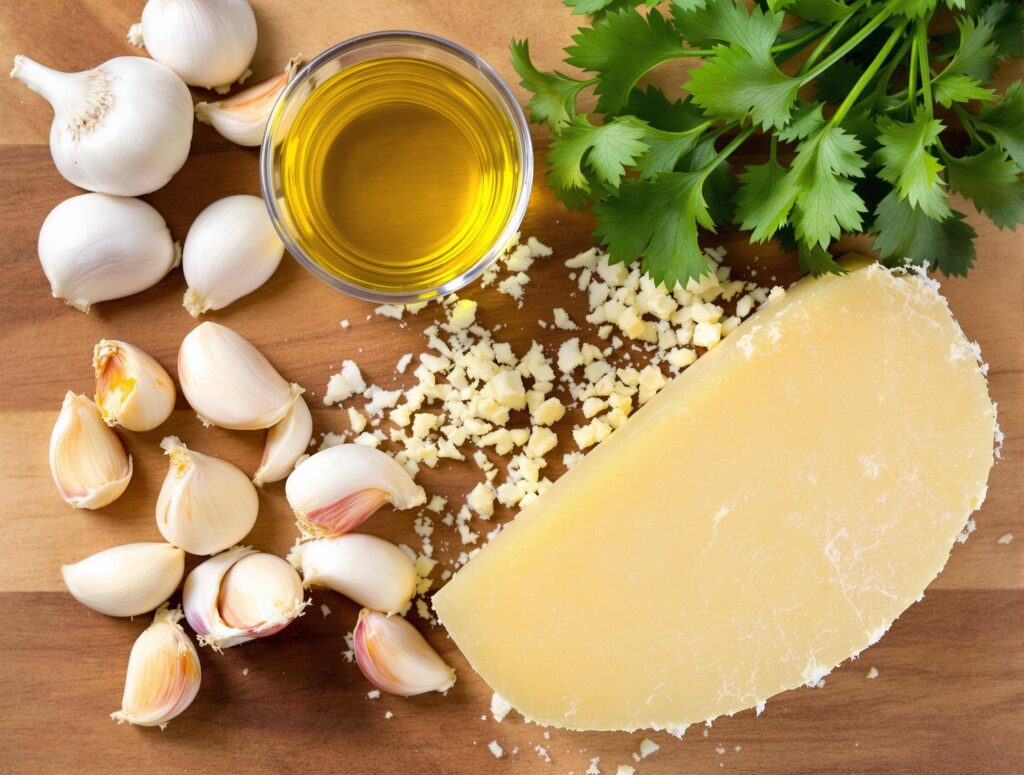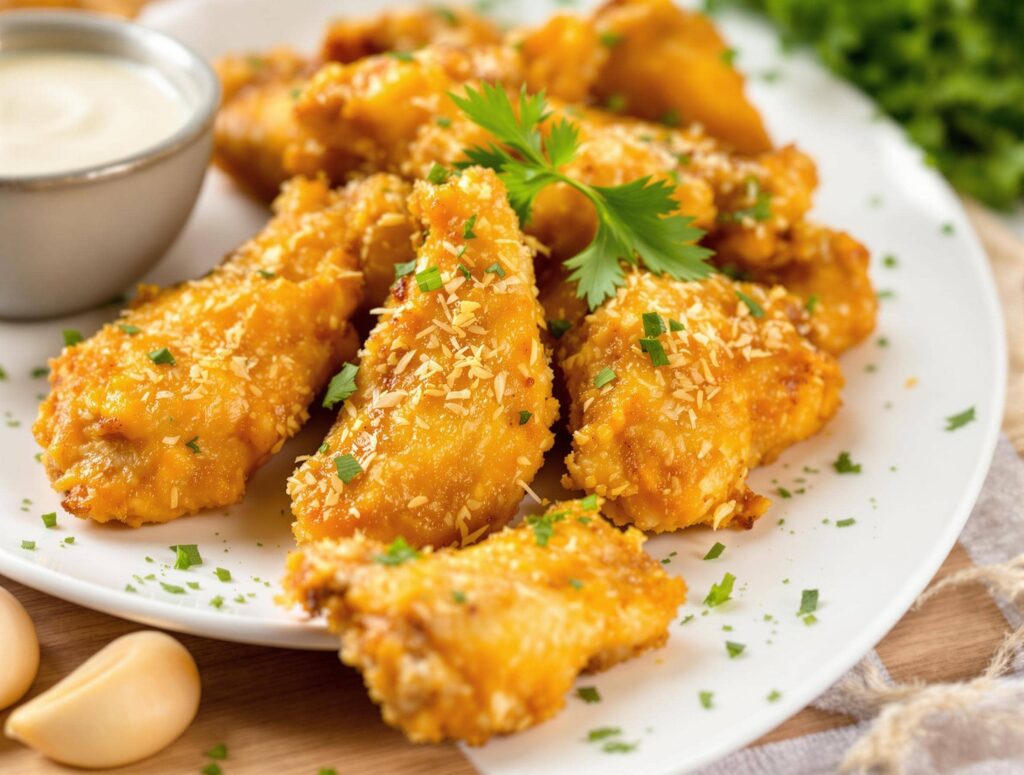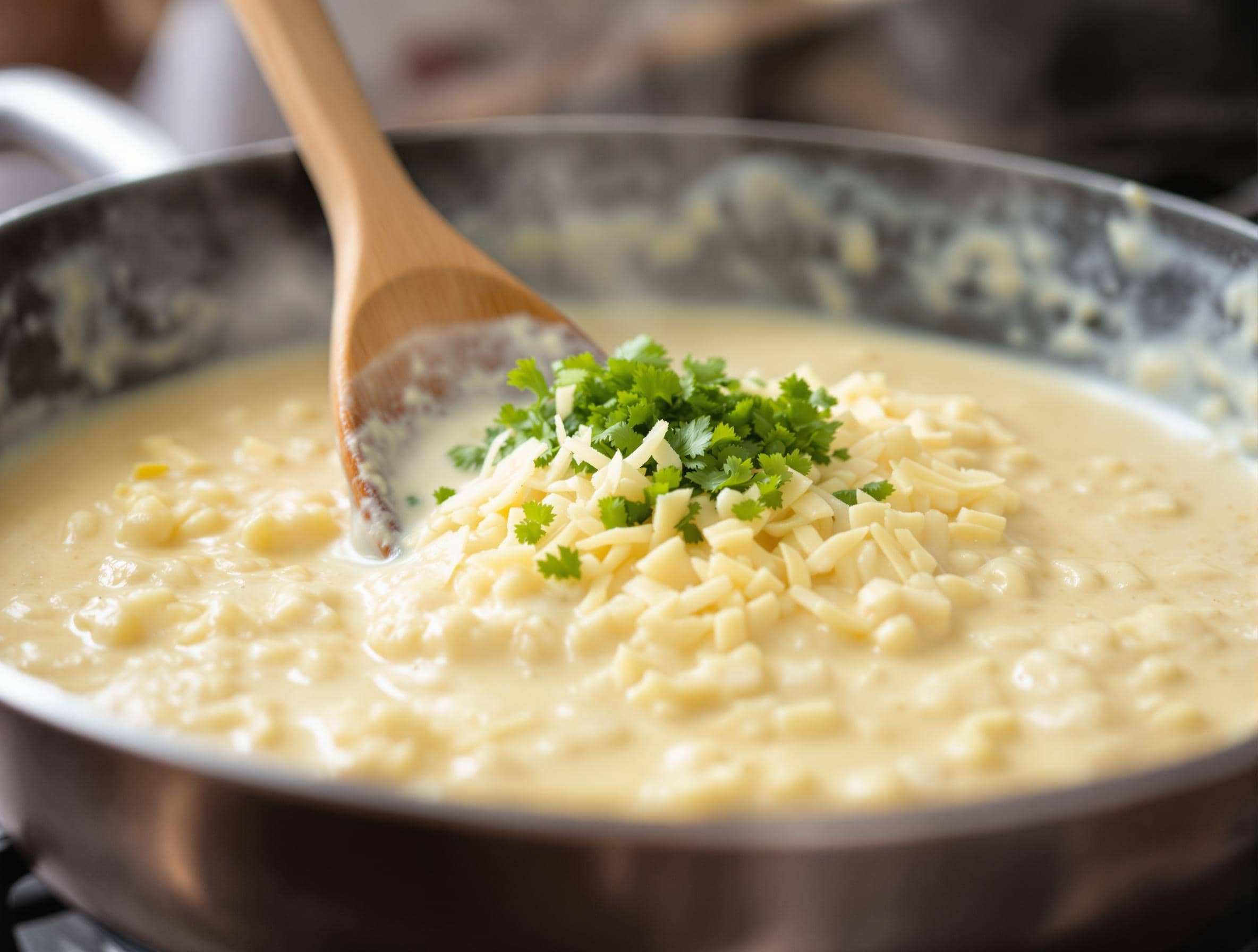Garlic Parmesan is one of the most beloved flavor combinations in kitchens around the world. Whether it’s coating crispy chicken wings, tossed with pasta, or used as a seasoning for snacks, the unique pairing of garlic and Parmesan cheese creates a rich, savory taste. But what exactly this sauce is made of?
In this article, we’ll explore the simple yet delicious ingredients that make up garlic Parmesan, the science behind its mouthwatering flavor, and how you can use it in your own cooking. From traditional recipes to surprising culinary tips, you’ll learn everything about this popular combination.
The Basics of Garlic Parmesan
Ingredients in Garlic Parmesan
At its core, this is a simple mixture of two main ingredients: garlic and Parmesan cheese. These two elements work together to create a savory, slightly nutty, and aromatic flavor that’s hard to resist. However, in most recipes or pre-made products, additional ingredients are often included to enhance the taste and texture. These may include:
- Butter or Olive Oil: Used as a base to bind the garlic and Parmesan while adding richness.
- Herbs: Parsley, oregano, or basil are common choices for adding a fresh, green touch.
- Salt and Pepper: To balance the flavors and enhance the natural taste of the main ingredients.
- Optional Spices: Red pepper flakes for heat or paprika for a smoky undertone.
The Role of Garlic and Parmesan Cheese
Garlic is known for its bold, aromatic quality. When raw, it has a pungent and sharp flavor, but when cooked, it becomes sweet, mellow, and nutty. This transformation is key in this recipes, as it ensures the garlic doesn’t overpower the dish.
Parmesan cheese, on the other hand, brings a salty, umami-rich flavor. Aged Parmesan is crumbly and intensely flavorful, making it perfect for grating over dishes or mixing into sauces. It complements garlic beautifully, creating a balanced and layered taste profile.
Why These Ingredients Matter
The beauty of it lies in its simplicity. Both garlic and Parmesan are pantry staples with long culinary histories. Together, they form a base that can be customized to suit different tastes, whether through added spices, herbs, or other cheeses.
The Flavor Profile
Why Garlic and Parmesan Blend So Well
it make a perfect pair because of how their flavors complement each other. Garlic’s sharp, slightly spicy aroma is softened by the nutty and salty richness of Parmesan cheese. This combination creates a balanced taste that is both bold and comforting.
The key flavor notes include:
- Savory (Umami): Parmesan cheese is packed with umami, a flavor that enhances the savory appeal of any dish.
- Aromatic: Garlic provides a rich, fragrant aroma that stimulates the senses.
- Mild Sweetness: When garlic is cooked, it develops a caramelized sweetness that balances Parmesan’s saltiness.
- Slight Saltiness: Parmesan cheese naturally contains salt, which enhances the overall flavor.
Common Seasoning Additions
While garlic and Parmesan are the stars, additional ingredients often elevate the flavor profile. These include:
- Butter: Adds creaminess and richness, making the dish more luxurious.
- Olive Oil: Provides a fruity, smooth base that binds the flavors together.
- Herbs: Fresh parsley or dried Italian herbs add freshness and depth.
- Lemon Juice: A squeeze of lemon can brighten the dish and balance the richness.
- Red Pepper Flakes: For those who love a bit of heat, red pepper flakes add a spicy kick.
These seasonings and enhancements allow this sauce to adapt to a variety of dishes, from pastas and roasted vegetables to chicken wings and breads.
How the Flavor Works in Dishes
When it is used in recipes, its flavor is versatile yet distinctive. For instance:
- On pasta, it provides a creamy, cheesy sauce with a punch of garlic.
- On roasted vegetables, it adds a crispy, flavorful coating.
- As a seasoning for wings, it combines a buttery richness with a sharp, tangy bite.
The adaptability of it is part of what makes it so popular in kitchens worldwide.
How Garlic Parmesan is Made

Traditional Recipe
Making itis simple and involves:
- Preparing Garlic: Peel and mince fresh garlic, then sauté it in butter or olive oil over low heat until aromatic.
- Adding Parmesan: Stir in grated Parmesan to create a creamy mixture.
- Seasoning: Add salt, pepper, herbs, or spices like red pepper flakes for extra flavor.
- Using It: Toss with pasta, spread on bread, or coat meats and vegetables.
Quick Alternatives
- Use pre-made the sauce seasoning for convenience.
- Bake garlic, Parmesan, and butter on bread or veggies for a crispy finish.
- Add cream to make a richer sauce.
This flexibility makes it a favorite in many kitchens.
Culinary Uses
Popular Dishes and Applications
it is incredibly versatile and can be used in countless recipes. Some of the most popular ways include:
- Garlic Parmesan Wings: Tossed in a buttery, cheesy sauce, these wings are a crowd favorite for parties and game nights.
- Pasta Dishes: Mixed with cream or butter, garlic Parmesan makes a rich and savory sauce for fettuccine, spaghetti, or penne.
- Roasted Vegetables: Coating vegetables like broccoli, cauliflower, or zucchini with the sauce before roasting adds a flavorful crust.
- Garlic Bread: A spread of garlic Parmesan butter on baguettes or rolls, baked to golden perfection, is a classic side dish.
Versatility in Cooking
Beyond these staples, it is adaptable to a variety of cuisines and meals:
- Pizza Topping: Sprinkle over pizzas for an extra layer of cheesy, garlicky goodness.
- Soups: Stir into creamy soups like potato or mushroom for a boost of flavor.
- Snacks: Use as a seasoning for popcorn, fries, or even chips.
Its robust flavor makes it an ideal addition to recipes that need a savory, aromatic touch.
Nutritional Value
Calories and Macros
itis both flavorful and nutrient-rich, but its nutritional profile varies depending on the recipe. Here’s a general breakdown:
- Calories: A typical serving (1 tablespoon) contains about 80-100 calories, primarily from fats in butter or olive oil and Parmesan cheese.
- Fats: Rich in healthy fats from olive oil or butter, contributing to its creamy texture.
- Protein: Parmesan cheese adds a decent amount of protein, around 2-4 grams per serving.
- Carbohydrates: Minimal carbs, making it a great option for low-carb or keto diets.
Health Benefits

- Garlic’s Properties: Garlic is known for its potential health benefits, including immune system support and heart health due to its antioxidants and sulfur compounds.
- Parmesan’s Nutrients: Parmesan is packed with calcium and protein, essential for strong bones and muscles.
- Healthy Fats: Olive oil or butter provides energy and helps the body absorb fat-soluble vitamins.
Considerations
While delicious, it can be high in sodium due to the Parmesan cheese and added salt. Moderation is key for those watching their salt intake. Adjustments like using unsalted butter or reduced-sodium Parmesan can make it more diet-friendly.
you might also like:
You Might Also Like
If you’re a fan of rich and savory flavors like garlic Parmesan, you’ll love exploring more culinary delights. Check out our delicious Garlic Parmesan Sauce and Salmon Bites Recipe for a creamy, indulgent pairing of seafood and bold flavors. Craving something hearty? Don’t miss our Alice Springs Chicken recipe—a mouthwatering dish featuring tender chicken smothered in cheese, bacon, and savory sauces. Both are perfect additions to your recipe collection and showcase the versatility of garlic Parmesan!
FAQs
What’s the difference between Parmesan and garlic Parmesan?
Parmesan is a hard, aged cheese with a salty, nutty flavor. Garlic Parmesan refers to a combination of garlic, Parmesan, and other seasonings, often used as a sauce, seasoning, or topping.
Can garlic Parmesan be made vegan?
Yes! Substitute Parmesan with nutritional yeast or a plant-based cheese alternative and use vegan butter or olive oil instead of dairy-based butter.
How do I store garlic Parmesan?
Store the sauce or seasoning in an airtight container. Keep sauces in the refrigerator for up to a week and dry seasoning in a cool, dry place for several months.
Is garlic Parmesan keto-friendly?
Yes! Garlic Parmesan is naturally low in carbs, making it a popular choice for keto diets, especially in recipes like wings or roasted vegetables.
Can I freeze garlic Parmesan sauce?
Yes, garlic Parmesan sauce can be frozen in an airtight container for up to three months. Thaw and reheat gently before using.
What dishes pair best with garlic Parmesan?
it pairs perfectly with pasta, chicken wings, roasted vegetables, and bread. It’s also great as a seasoning for snacks like fries or popcorn.
Conclusion
itarlic Parmesan is a timeless combination that delivers bold flavors and unmatched versatility. Made from simple ingredients like garlic, Parmesan cheese, butter, and herbs, this pairing creates a rich and savory taste that enhances countless dishes.
From crispy chicken wings to creamy pasta and roasted vegetables, it adds depth and indulgence to every bite. It’s not just delicious but also nutrient-packed, offering benefits from garlic’s antioxidants and Parmesan’s calcium and protein.
Whether you prepare it fresh at home or use store-bought blends, it is a staple that transforms everyday recipes into gourmet experiences. With its simplicity and adaptability, it’s no wonder this flavor combination remains a favorite in kitchens around the world.

